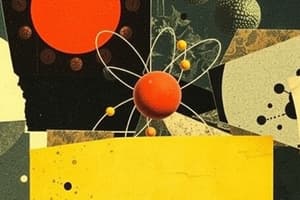Podcast
Questions and Answers
What are the 3 main subatomic particles?
What are the 3 main subatomic particles?
Protons, neutrons, and electrons.
What is in the nucleus of an atom?
What is in the nucleus of an atom?
Protons and neutrons.
How does the diameter of the nucleus compare to the diameter of the atom?
How does the diameter of the nucleus compare to the diameter of the atom?
The larger the diameter of the nucleus, the larger the atom in both diameter and mass.
What are protons? What is their charge? Where are they located?
What are protons? What is their charge? Where are they located?
What are neutrons? What is their charge? Where are they located?
What are neutrons? What is their charge? Where are they located?
What are electrons? What is their charge? Where are they located?
What are electrons? What is their charge? Where are they located?
How does the mass of an electron compare to protons and neutrons?
How does the mass of an electron compare to protons and neutrons?
An atom is neutral if the number of protons and electrons are what? Why?
An atom is neutral if the number of protons and electrons are what? Why?
What is an ion? A positive ion? A negative ion?
What is an ion? A positive ion? A negative ion?
How many subatomic particles are in the simplest atom? What element is the simplest atom?
How many subatomic particles are in the simplest atom? What element is the simplest atom?
What is the atomic number of an element?
What is the atomic number of an element?
What is the atomic number of carbon? Iron?
What is the atomic number of carbon? Iron?
What is the mass number? Why aren't electrons included in the mass number?
What is the mass number? Why aren't electrons included in the mass number?
The mass number of sodium is 23. How many protons and neutrons does it have?
The mass number of sodium is 23. How many protons and neutrons does it have?
Flashcards
3 Main Subatomic Particles
3 Main Subatomic Particles
Protons, neutrons, and electrons.
What's in an atom's nucleus?
What's in an atom's nucleus?
Protons and neutrons.
What are protons?
What are protons?
Protons are positively charged subatomic particles found in the nucleus.
What are neutrons?
What are neutrons?
Signup and view all the flashcards
What are electrons?
What are electrons?
Signup and view all the flashcards
Mass of an electron vs. protons/neutrons
Mass of an electron vs. protons/neutrons
Signup and view all the flashcards
When is an atom neutral?
When is an atom neutral?
Signup and view all the flashcards
What is an ion?
What is an ion?
Signup and view all the flashcards
Simplest atom
Simplest atom
Signup and view all the flashcards
Atomic Number
Atomic Number
Signup and view all the flashcards
Atomic numbers of carbon and iron
Atomic numbers of carbon and iron
Signup and view all the flashcards
Mass Number
Mass Number
Signup and view all the flashcards
Electrons in Mass Number?
Electrons in Mass Number?
Signup and view all the flashcards
Sodium Particle Count (Mass Number 23)
Sodium Particle Count (Mass Number 23)
Signup and view all the flashcards
Study Notes
Subatomic Structure Overview
- Three primary subatomic particles: protons, neutrons, and electrons.
Nucleus Composition
- The nucleus is composed of protons and neutrons, forming the dense core of an atom.
Nucleus Size Relationship
- A larger nucleus diameter corresponds to a larger overall atom diameter and increased mass.
Protons
- Protons are located in the nucleus, carry a positive charge, and define the atomic number of an element.
Neutrons
- Neutrons also reside in the nucleus, possess no charge (neutral), and contribute to atomic mass alongside protons.
Electrons
- Electrons are negatively charged particles found in energy levels surrounding the nucleus, organized in an electron cloud.
Electron Mass Comparison
- The mass of an electron is significantly smaller than that of protons and neutrons, about 1/1830, contributing negligibly to atomic mass.
Atomic Neutrality
- An atom is neutral when the number of protons equals the number of electrons, balancing positive and negative charges.
Ions
- Ions are charged atoms, formed by the exchange of electrons.
- Positive ions have more protons than electrons, while negative ions have more electrons than protons.
Simplest Atom
- The simplest atom, hydrogen, contains one proton and one electron.
Atomic Number
- The atomic number indicates the number of protons in an element, which defines the element's identity.
Specific Atomic Numbers
- Carbon has an atomic number of 6, while iron has an atomic number of 26.
Isotopes and Mass Number
- The mass number combines the total count of protons and neutrons, while electrons are excluded due to their minimal mass.
Sodium Example
- Sodium has an atomic number of 11 (11 protons); with an atomic mass of 23, it has 12 neutrons (23 - 11 = 12).
Studying That Suits You
Use AI to generate personalized quizzes and flashcards to suit your learning preferences.




